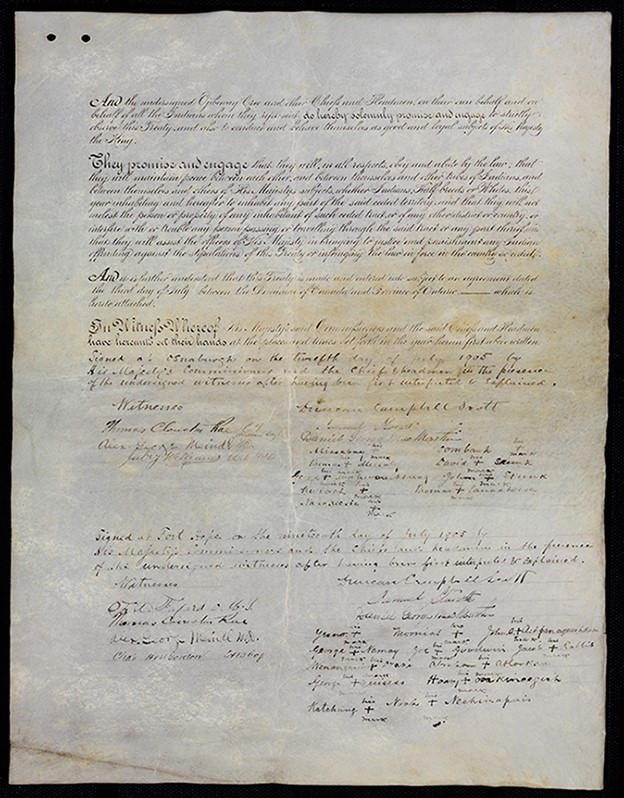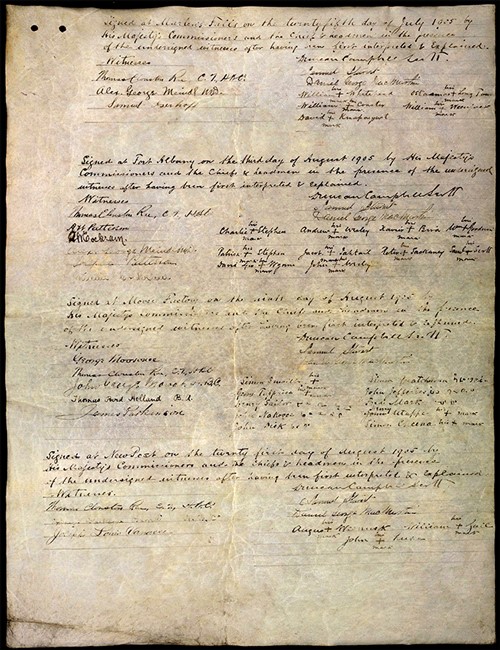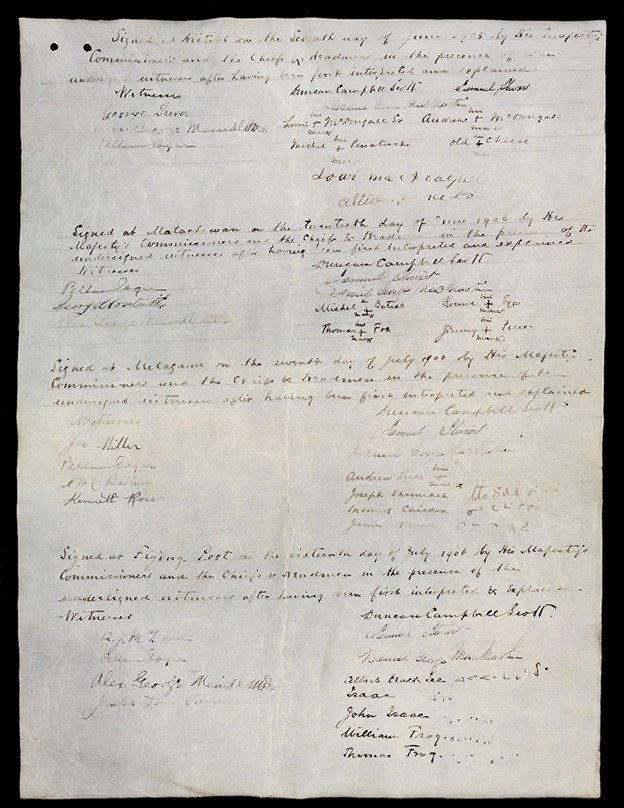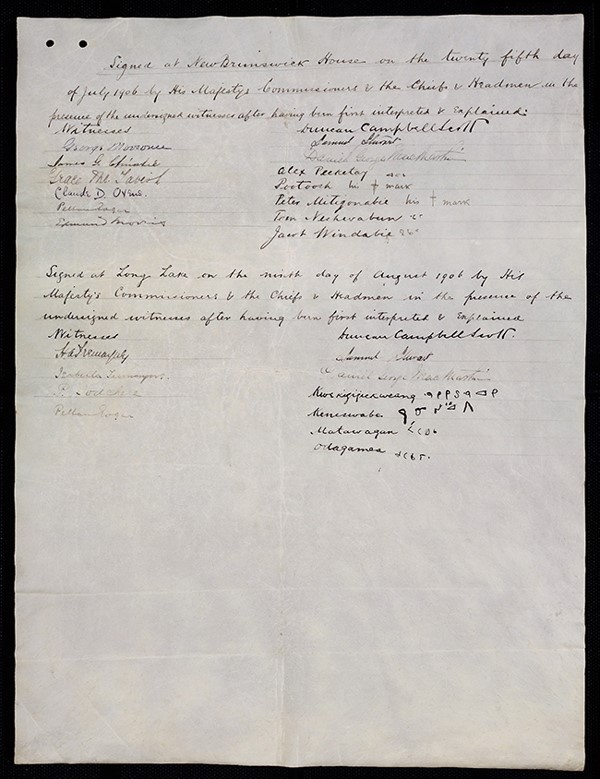Compiled by Sheila Wheesk, GRASAC Research Assistant
Overview
Dates
- An original digital image of Treaty no.9 and its terms is on the Ontario Archives website. The treaty terms indicate that Treaty no. 9 was first signed in 1905-1906 that began on July 12, 1905, at Osnaburg, July 19, 1905, at Fort Hope, On July 19, 1905, at Martin Falls, On August 3, 1905, at Fort Albany, On August 3, 1905, at Fort Albany, 5 On and August 25, 1905, at New Post.
- In 1906, Treaty no. 9 began on On June 7, 1906, at the Abitibi, On June 29, 1906, at Matachewan, On July 7, 1906, at Mattagami, On July 16, 1906, at Flying Post, On July 25, 1906, at New Brunswick House, and On August 9, 1906, at the Treaty at Long Lake.
Additionally, Canada, the Anishinaabek and the Omushkegowuk signed an adhesion to Treaty no. 9 in 1929-1931.
- Trout Lake, on July 5, 1929,
- Windigo River on July 18, 1930,
- Fort Severn on July 25, 1930,
- Winisk on July 28, 1930,
Places
The Canadian Government’s website acknowledges that Treaty no. 9 covers two thirds of Northern Ontario.
Nations and Representatives
Treaty No. 9 took Place between the Omushkegowuk (Cree), the Anishinabek (Ojibwa) and His Majesty, the King of Great Britain and Ireland.
The document lists the treaty negotiators’ names for the Federal government: Duncan Campbell Scott of Ottawa, and Samuel Stewart, Esquire of Ottawa.
The Provincal government lists Daniel George MacMartin, Esquire Perth.
The Anishinabek (Ojibwa) community leaders-ogimaa
The Omushkegowuk (Cree) community leaders-okimaw
According to His Majesty’s commissioners, the Omushkegowuk (Cree), and the Anishinabek (Ojibwa) received the proper Interpretation of the Treaty before signing the document in 1905/1906.
On July 12, 1905, at Osnaburg, the following people signed the Treaty. Canada’s Commissioners are the witnesses.
The Osnaburg Chief, Missabay, marked his signature with an X, and the eight headmen marked their signatures with an X. The Commissioners, Duncan Campbell Scott, Samuel Stewart, Daniel George MacMartin, and Thomas Clouston RAE, C. T., Hudson’s Bay Co. (HBC) bear witness.
On July 19, 1905, at Fort Hope, the following people signed the Treaty: The Chief and their headmen. Canada’s Commissioners and the witnesses.
The Fort Hope Chief, Yesno, marked his signature with an X, and the eleven headmen’s signature with an X, the Commissioners, Duncan Campbell Scott, Samuel Stewart, Daniel George MacMartin, and the witnesses, F.X Farard, O.M.I, Thomas Clouston R.A.E, Alex George Meindl, MD. CHAS. H M., and Gordon, HBC.
On July 19, 1905, at Martin Falls, the following people signed the Treaty: The Chief and their headmen. Canada’s Commissioners and the witnesses.
The Martin Falls Chief, William Whitehead, marked his signature with an X, and the five headmen’s signature with an X, the Commissioners Duncan Campbell Scott, Samuel Stewart, Daniel George MacMartin, the witnesses, Thomas Clouston RAE, CT, HBC, Alex George Meindl, and MD. Samuel Iserhoff.
On August 3, 1905, at Fort Albany, the following people signed the Treaty: The Chief and their headmen. Canada’s Commissioners and the witnesses.
The Fort Albany Chief, Charlie Stephen, marked his signature with an X, and the nine headmen’s signature with an X, the Commissioners Duncan Campbell Scott, Samuel Stewart, Daniel George MacMartin, the witnesses, Thomas Clouston RAE, CT, A. W. Patterson, G. W. Cochrane, Alex George Meindl, M.D, Joseph Patterson, and Minnie Cockram.
On August 9, 1905, at Moose Factory, the following people signed the Treaty: The Chief and their headmen. Canada’s Commissioners and the witnesses.
The Moose Factory Chief, Simon Smallboy, marked his signature with an X, and the nine headmen’s signature with an X, the Commissioners Duncan Campbell Scott, Samuel Stewart, Daniel George MacMartin, the witnesses, Thomas Clouston RAE, C.T., John George Mowat, HBC, Thomas Bird Holland, and B.A., James Parkinson.
On August 25, 1905, at New Post, the following people signed the Treaty: The Chief and their headmen. Canada’s Commissioners and the witnesses.
The New Post Chief, Angus Weenusk, marked his signature with an X, and the three headmen’s signature with an X, the Commissioners Duncan Campbell Scott, Samuel Stewart, Daniel George MacMartin, and Thomas Clouston RAE, C.T., Sydney Blenkarne Barrett, H.B. Co., and Joseph Louis Vanasse.
On June 7, 1906, at Abitibi, the following people signed the Treaty: The Chief and their headmen. Canada’s Commissioners and the witnesses.
The Abitibi Chief, Louis McDougall, SR., marked his signature with an X. The six headmen’s signature with an X, the Commissioners Duncan Campbell Scott, Samuel Stewart, Daniel George MacMartin, and the witnesses, George Drever, Alex. George Meindl, MD, and Pelham Edgar.
On June 29, 1906, at Matachewan, the following people signed the Treaty: The Chief and their headmen. Canada’s Commissioners and the witnesses.
The Matachewan Chief, Michel Batiste, marked his signature with an X. The three headmen’s signature with an X, the Commissioners Duncan Campbell Scott, Samuel Stewart, Daniel George MacMartin, and the witnesses, Pelham Edgar, George Monteith, Alex. George, and Meindl, M.D.
On July 7, 1906, at Mattagami, the following people signed the Treaty: The Chief and their headmen. Canada’s Commissioners and the witnesses.
The Mattagami Chief, Andrew Luke, marked his signature with an X. The three headmen’s signature with an X, the Commissioners Duncan Campbell Scott, Samuel Stewart, Daniel George MacMartin, and the witnesses, Jos Miller, Pelham Edgar, A. M. C. Banting, and Kenneth Ross.
On July 16, 1906, at Flying Post, the following people signed the Treaty: The Chief and their headmen. Canada’s Commissioners and the witnesses.
The Flying Post Chief, Albert Black Ice, signed with Cree syllabics. The two headmen signed with Cree syllabics. One headman had an X signature, the Commissioners Duncan Campbell Scott, Samuel Stewart, Daniel George MacMartin, and Joe’s witnesses. Miller, Pelham Edgar, A., M. C. Banting, and Kenneth Ross.
On July 25, 1906, at New Brunswick House, the following people signed the Treaty: The Chief and their headmen. Canada’s Commissioners and the witnesses.
The New Brunswick House’s Chief, Alex Peeketay, signed with Cree syllabics, and the three headmen’s signature with Cree syllabics, the Commissioners Duncan Campbell Scott, Samuel Stewart, Daniel George MacMartin, and the witnesses, George Moosonee, James G. Christie, Grace McTavish, Claude D. Ovens, Pelham Edgar, and Edmund Morris. A. M. C.
On August 9, 1906, at Long Lake, the following people signed the Treaty: The Chief and their headmen. Canada’s Commissioners and the witnesses.
The Long Lake’s Chief, Kwakigigickweang, signed in syllabics, and the three headmen signed in syllabics, the Commissioners Duncan Campbell Scott, Samuel Stewart, Daniel George MacMartin, and the witnesses, H.E. Tremayne, Isabella Tremayne, P. Godchere, and Pelham Edgar also have their signature on the document.
Negotiations
The following information comes from Making Treaty (Treaty No. 9), from the Ontario Ministry of Government and Consumer Services, and from the Daniel George W. MacMartin Collection.
The Federal Commissioner (Ducun Campbell Scott) and Provincial Commissioner (George MacMartin) informed the Indians (Anishinabek -Ojibwa and Omushkegowuk-Cree) of the Government’s intention. Furthermore, they stated that the New Dominion of Canada needed land for the new settlers, and they also needed to extract and mine their natural resources for their economy. Therefore, the Government needs their consent.
The Federal and Provincial governments negotiate a treaty with the Anishinaabek -Ojibwa and Omushkegowuk-Cree in northern Ontario and the western James Bay region. Nonetheless, the commissioners asked that the Anishinabek -Ojibwa and Omushkegowuk-Cree select a leader to sign the Treaty on their village’s behalf. Nevertheless, the commissioners began to negotiate a treaty with the Anishinabek -Ojibwa and Omushkegowuk-Cree leaders and community members to release their ties to all the lands they had lived on since the time of immemorial.
Conversely, the Anishinabek -Ojibwa and Omushkegowuk-Cree also release their ties to the land where the Indians relocate, and the Government possesses the land forever.
However, the Government agrees that the Anishinabek -Ojibwa and Omushkegowuk-Cree can continue to survive on the land the way they always have, except that the Government needs the land for settlement and resource extraction.
The Government agreed to set aside land that the Indians could live on and pay to map the land. The amount of land depends on the number of families; therefore, the Crown has not decided what land to map. The grounds set aside are not confirmed yet, but the Indians who will live there will not owe any money to Ontario when they do. The Government is willing to give each family of five one square mile of land to live. Furthermore, the Government will deal with any settlers who live within land set aside for the Indians. The Government will also only sell the land with the Indians’ consent. The Indians cannot separate the land from the rest of the country. The Government can also take back the land for any purpose or reason, and the Government can give an equal amount of value to a portion of the land taken. In exchange for everything the Indians give, the Government agrees to pay them eight dollars for each member. The Government will pay four dollars the next year and forever at certain places that Government chooses. Thus, every chief will receive a flag and a copy of this Treaty. The Government agrees to provide schools with educational provisions and teachers for the children in this region. Everybody who signs this Treaty is responsible for all the Indians obeying this Treaty and the Government. The Indians have to follow the law and not bother any other people, meaning the settlers, on the land.
Sources
Primary Documents
Heritage Items
None identified yet.
Language Items
- ogimaa (Anishinaabemowin): Anishinabek (Ojibwa) community leader
- okimaw (Cree): Omushkegowuk (Cree) community leader
- miksa studen (Cree): beaded caps (according to Ellen Smallboy)
Secondary Sources
- Bohaker, Heidi. 2020. Doodem and Council Fire. Toronto: University of Toronto Press.
- Borrows, John, and Michael Coyle. 2017. The Right Relationship . Toronto-Buffalo-London: University of Toronto Press.
- Calverley , David. 2006. “The Impact of the Hudson’s Bay Company on the creation of Treaty Number Nine,.” Ontario History (Ontario Historical Society ) 98 (1): 30-51.
- Gettler, Brian. 2020. Colonialism’s Currency Money, State, and First Nations In Canada, 1820-1950. Montreal & Kingston: McGill-Queen’s University Press.
- Long, John S. 2010. Treaty No. 9: Making the Agreement to Share the Land in Far Northern Ontario in 1905. Montreal: MQUP.
- Long, John S., Richard J. Preston, Katrina Srigley, and Lorraine Sutherland. 2017. “Sharing the Land at Moose Factory in 1763.” Ontario History (The Ontario Historical Society) 109 (2): 238-262.
- Macklem, Patrick . 1997. “The Impact of Treaty 9 on Natural Resource Development in Northern Ontario.” In Aboriginal and treaty rights in Canada essays on law, equity, and respect for difference, by Michael Asch. Vancouver , British Columbia : UBC Press.
- 1905. “MacMartin Diary-1905.” Ontario: Queen’s University Archives.
- Morrison, James. 1986. Treaty Nine (1905-1906): The James Bay Treaty. Ottawa, Ontario: Minister of Indian Affairs and Northern Development.
- Ontario.ca. 2012-2014. “Making the Treaty.” Ontario Ministry of Government and Consumer Services. Ottawa, Ontario: Archieves Ontario Government.
- Titley, Brian E. 1986. A Narrow Vision: Duncan Campbell Scott in the Department of Indian Affairs between 1880 and 1932. Vancouver, British Columbia : University of British Columbia Press.
Other
- Wheesk, Sheila. 2021. “From the GKS: A Cloth Woman’s Beaded Hood.”
If you have information, events, or sources to add to this page, or if you would like to make a correction to it, please contact us by clicking here. Miigwetch, nia:wen, merci, thank you.
Return to the GRASAC Treaty Timeline.






